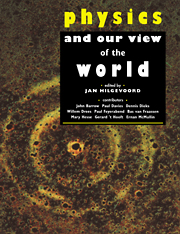Book contents
- Frontmatter
- Contents
- Foreword
- Introduction
- 1 Questioning the answers or Stumbling upon good and bad Theories of Everything
- 2 Theories of Everything
- 3 The scientific view of the world: introduction
- 4 Enlarging the known world
- 5 The world of empiricism
- 6 Has the scientific view of the world a special status compared with other views?
- 7 Quantum theory and our view of the world
- 8 Interpretation of science; science as interpretation
- 9 Problems in debates about physics and religion
- 10 The mind of God
- 11 The sources of models for God: metaphysics or metaphor?
- Discussion
- Notes on contributors
- Bibliography
- Index
2 - Theories of Everything
Published online by Cambridge University Press: 04 December 2009
- Frontmatter
- Contents
- Foreword
- Introduction
- 1 Questioning the answers or Stumbling upon good and bad Theories of Everything
- 2 Theories of Everything
- 3 The scientific view of the world: introduction
- 4 Enlarging the known world
- 5 The world of empiricism
- 6 Has the scientific view of the world a special status compared with other views?
- 7 Quantum theory and our view of the world
- 8 Interpretation of science; science as interpretation
- 9 Problems in debates about physics and religion
- 10 The mind of God
- 11 The sources of models for God: metaphysics or metaphor?
- Discussion
- Notes on contributors
- Bibliography
- Index
Summary
Introduction
Despite the topicality of Theories of Everything in the literature of science and its popular chronicles, they are at root a new edition of something very old indeed. If we cast our eyes over a range of ancient mythological accounts of the world we soon find that we have before us the first Theories of Everything. Their authors composed elaborate stories in which there was a place for everything and everything had its place. These were not in any modern sense scientific theories about the world, but tapestries within which the known and the unknown could be inter-woven to produce a single meaningful picture in which the authors could place themselves with a confidence born of their interpretation of the world around them. In time, as more things were discovered and added to the stories, so they became increasingly contrived and complicated. Moreover, whilst these accounts aimed at great breadth when assimilating perceived truths about the world into a single coherent whole, they were totally lacking in depth. That is, in the ability to extract more from their story than what was put into it in the first place. Modern scientific theories about the world place great emphasis upon depth — the ability to predict new things and explain phenomena not incorporated in the specification of the theory initially.
Information
- Type
- Chapter
- Information
- Physics and our View of the World , pp. 38 - 60Publisher: Cambridge University PressPrint publication year: 1994
Accessibility standard: Unknown
Why this information is here
This section outlines the accessibility features of this content - including support for screen readers, full keyboard navigation and high-contrast display options. This may not be relevant for you.Accessibility Information
- 5
- Cited by
